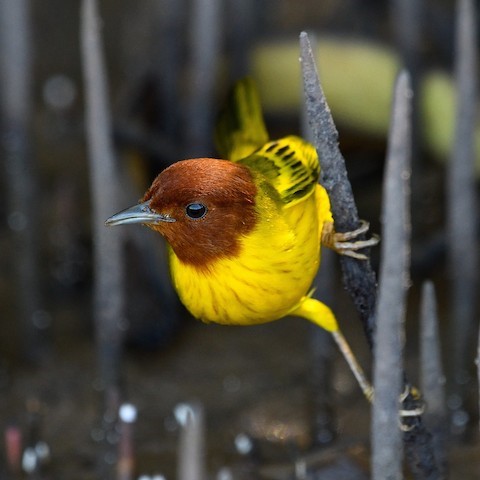Birdfinding.info ⇒ The continental Latin American mangrove specialist form of American Yellow Warbler is locally common in its favored habitat—where it is often very common but also very localized. Especially common on the Yucatán Peninsula from northern Campeche to Belize and along the Pacific Coast of Central America from Chiapas to Panama. In Texas it has been found consistently at Boca Chica Beach and along the Laguna Madre at Laguna Atascosa and South Padre Island.
“Mangrove Warbler”
Setophaga petechia erithachorides
Mangrove swamps from Middle America to northwestern South America.
The fourteen subspecies that are most universally regarded as comprising the “Mangrove Warbler” (as distinguished from the many closely related subspecies that comprise the “Golden Warbler”) are localized residents of mangrove swamps along the continental coasts of Latin America and some nearby islands.
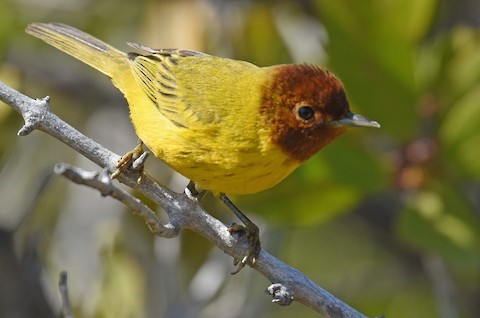
“Mangrove Warbler”, male of the northwesternmost subspecies, castaneiceps. (Playa Balandra, La Paz, Baja California Sur, Mexico; January 25, 2020.) © Steven Mlodinow
Pacific populations occupy a disjunct distribution that roughly corresponds to nine recognized subspecies: (1) castaneiceps along both coasts of Baja California Sur; (2) rhizophorae from central Sonora to Colima; (3) phillipsi from eastern Oaxaca to central Nicaragua; (4) xanthotera in Costa Rica from the Golfo de Nicoya to the Osa Peninsula; (5) aithocorys in western Panama (Chiriquí and Veraguas) and nearby islands, including Coíba; (6) iguanae on Panama’s Isla Iguana (possibly also on the adjacent Azuero Peninsula); (7) aequatorialis in central Panama, including the Pearl Islands; (8) jubaris in Darién and northern Chocó; and (9) peruviana from southern Chocó to northwestern Peru (into Piura).
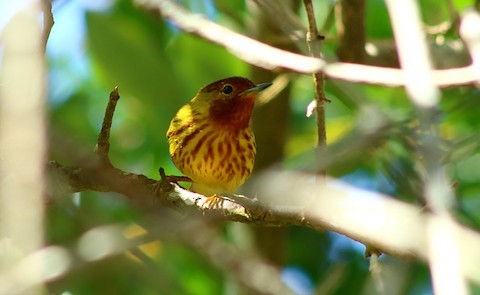
“Mangrove Warbler”, male of the Paraguaná Peninsula subspecies, paraguanae. (Laguna Boca de Caño, Falcón, Venezuela; December 3, 2020.) © Luis Hernández
Caribbean populations are divided into five recognized subspecies: (1) oraria along the Gulf of Mexico from southernmost Texas to southwestern Campeche; (2) bryanti on the Yucatán Peninsula from northern Campeche to southern Belize, and on several Belizean cayes and Guanaja (in the Honduran Bay Islands); (3) erithachorides from central Costa Rica (Moín) to eastern Panama; (4) chrysendeta from northern Colombia (around Barranquilla) east to Lake Maracaibo; and (5) paraguanae on Venezuela’s Paraguaná Peninsula (central Falcón).
An additional Caribbean subspecies, cienagae, recorded along the coast of Venezuela from eastern Falcón to Aragua, has been alternatively classified as either “Mangrove” or “Golden”. The 2017 Venezuelan field guide (Ascanio et al.) classifies cienagae with “Golden”.
Mostly sedentary, but wanderers have been found well beyond its normal range in California (Salton Sea, December 18, 2007; and San Diego, January to March 2009) and Arizona (Theodore Roosevelt Lake, July 31, 2004).
Identification
A distinctive form of American Yellow Warbler in which males of most races have a full chestnut hood. It is also, as its name suggests, strongly tied to mangroves, although a few local populations also occur in other habitats.
Males vary widely in the amount and distribution of chestnut on the head and breast.
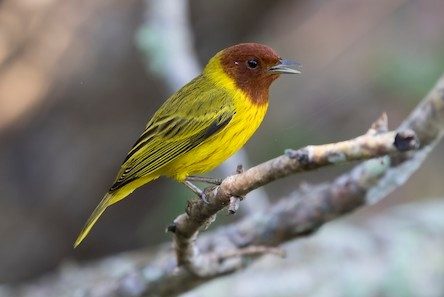
“Mangrove Warbler”, S. p. xanthotera, male. (Chomes, Puntarenas, Costa Rica; October 7, 2018.) © Jorge Gabriel Campos
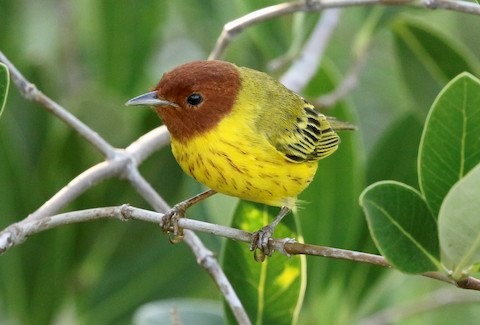
“Mangrove Warbler”, S. p. bryanti, male. (Ambergris Caye, Belize; November 15, 2019.) © John Bruin
Those of northern and central populations—from Mexico to Costa Rica—have a crisply defined hood and sparse, thin streaks on the chest and sides.
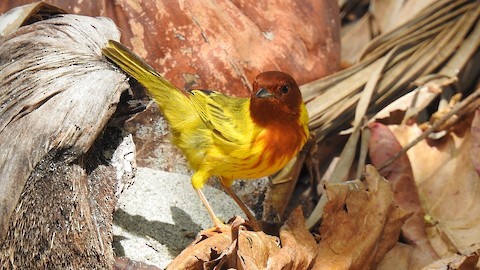
“Mangrove Warbler”, S. p. aithocorys, male with chestnut extending down onto the chest. (Isla Gómez, Chiriquí, Panama; March 20, 2021.) © Yasmin Cerrud Henríquez
Some Panamanian and South American populations differ in having vaguely defined hoods and broad streaks on the breast.
The throat and chest are especially variable and can be either orangish or deep chestnut—or mostly yellow in peruviana—which occurs from southwestern Colombia to northwestern Peru—and generally has chestnut only the crown, much like typical “Golden” and “Galápagos” males. (The Venezuelan cienagae resembles peruviana, and has been alternatively classified as either “Mangrove” or “Golden”.)

“Mangrove Warbler”, S. p. peruviana, male. (Playa del Morro, Nariño, Colombia; October 4, 2021.) © Glenn Seeholzer

“Mangrove Warbler”, S. p. paraguanae, female. (Laguna Boca de Caño, Falcón, Venezuela; April 14, 2021.) © David Ascanio
Females of most races are yellow-olive above and bright-yellow below, often with faint streaking on the breast and a rusty tinge on the crown and face. Some (such as castaneiceps in Baja California) are duller, olive overall, paler and yellower below.
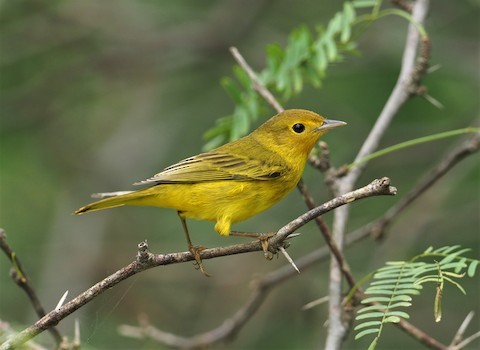
“Mangrove Warbler”, S. p. phillipsi, female. (El Paredon, Sipacate-Naranjo National Park, Guatemala; October 21, 2018.) © Daniel Aldana
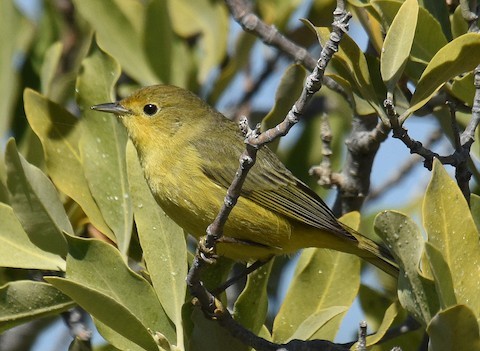
“Mangrove Warbler”, S. p. erithachorides, female. (Playa Balandra, La Paz, Baja California Sur, Mexico; January 25, 2020.) © Steven Mlodinow
Immatures generally resemble females but duller, in some cases essentially all-gray. When molting into adult plumage, immature males often show irregular patches of chestnut on the head.

“Mangrove Warbler”, S. p. castaneiceps, immature female. (La Paz, Baja California Sur, Mexico; December 16, 2011.) © Steven Mlodinow

“Mangrove Warbler”, S. p. aequatorialis, subadult male molting into adult plumage. (Claridad, Panama, Panama; May 17, 2018.) © Josanel Sugasti
Voice. The “Mangrove Warbler’s” song resembles those of other forms of the American Yellow Warbler complex, usually beginning with about two to four strong, evenly spaced sweet notes and ending with a quick jumble of sharper notes: Comparative analyses have determined that the songs of resident “Mangrove” and “Golden” forms are more complex than those of the migratory “Northern” form.
Notes
Polytypic form consisting of fourteen or fifteen recognized subspecies, collectively one of five potentially distinct forms of American Yellow Warbler (petechia). The fifteenth subspecies is the Venezuelan cienagae, which has been alternatively classified as part of either “Mangrove Warbler” (erithachorides) or “Golden Warbler” (petechia).
The taxonomy of American Yellow Warbler complex remains unsettled and subject to ongoing revisions. Many authorities divide the complex of 43 recognized subspecies into two species: (1) the mostly migratory “Northern Yellow Warbler” (aestiva); and (2) the 34 tropical resident subspecies. Under this arrangement, the name “Mangrove Warbler” (petechia) is usually used to refer to the latter group in the aggregate.
More Images of “Mangrove Warbler”
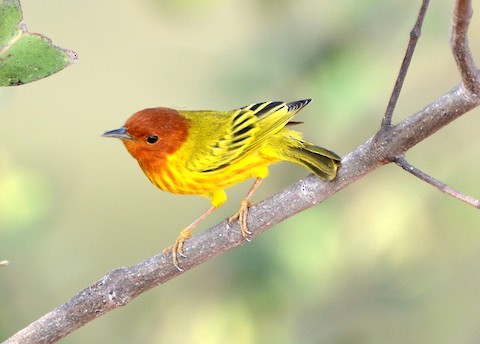
“Mangrove Warbler”, S. p. aequatorialis, male. (Punta Chame, Panama, Panama; March 12, 2016.) © Joanie & Mark Hubinger
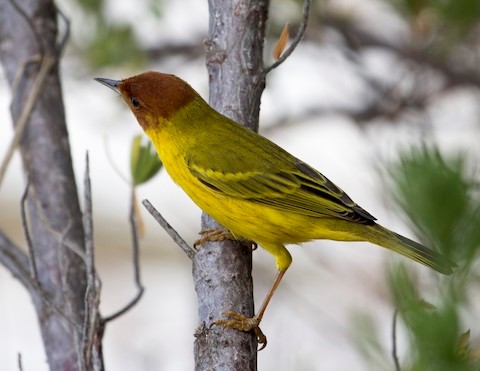
“Mangrove Warbler”, S. p. bryanti, male. (Isla Holbox, Quintana Roo, Mexico; March 11, 2016.) © Jan Allen
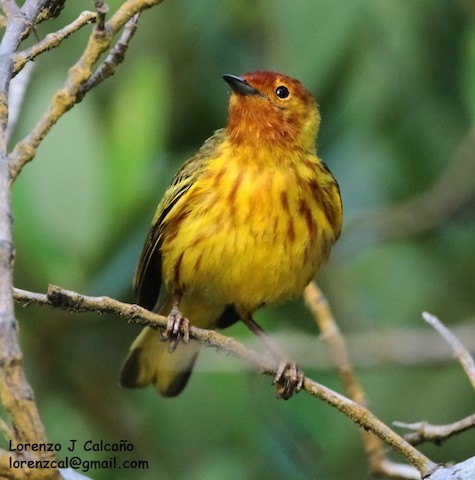
“Mangrove Warbler”, S. p. paraguanae, male. (Laguna Boca de Caño, Falcón, Venezuela; February 26, 2012.) © Lorenzo J. Calcaño
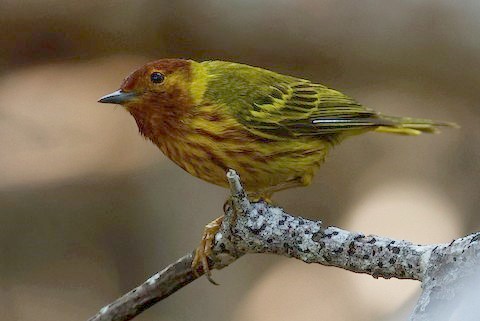
“Mangrove Warbler”, S. p. paraguanae, male. (Laguna Boca de Caño, Falcón, Venezuela; April 14, 2021.) © David Ascanio

“Mangrove Warbler”, S. p. peruviana, male. (Puerto Jelí, El Oro, Ecuador; March 25, 2019.) © Gil Ewing

“Mangrove Warbler”, S. p. peruviana, male. (Ayampe, Manabí, Ecuador; December 23, 2021.) © Bobby Wilcox
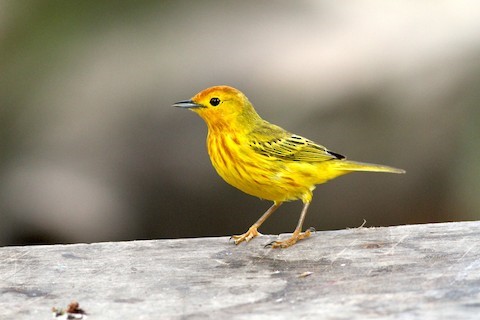
“Mangrove Warbler”, S. p. peruviana, male. (Playa del Morro, Nariño, Colombia; October 4, 2021.) © Glenn Seeholzer
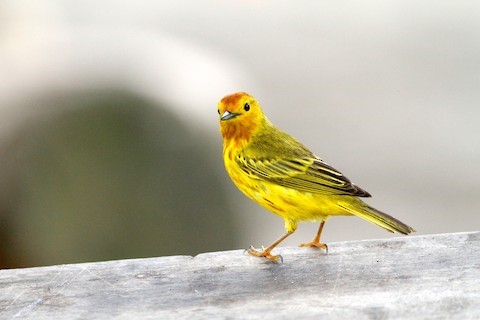
“Mangrove Warbler”, S. p. peruviana, male. (Playa del Morro, Nariño, Colombia; October 4, 2021.) © Glenn Seeholzer
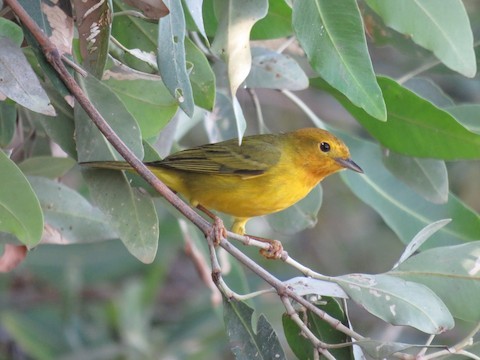
“Mangrove Warbler”, S. p. phillipsi, female. (Usulután, El Salvador; March 21, 2021.) © Melvin Bonilla
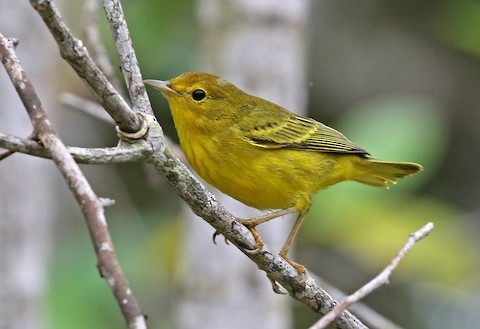
“Mangrove Warbler”, S. p. peruviana, female. (Majagual, Esmeraldas, Ecuador; September 19, 2020.) © Roger Ahlman

“Mangrove Warbler”, S. p. bryanti, female. (Hideaway Caye, Belize; December 11, 2017.) © Robert Johnson

“Mangrove Warbler”, S. p. bryanti, female. (Chicxulub, Yucatán, Mexico; January 11, 2020.) © Howard Cox
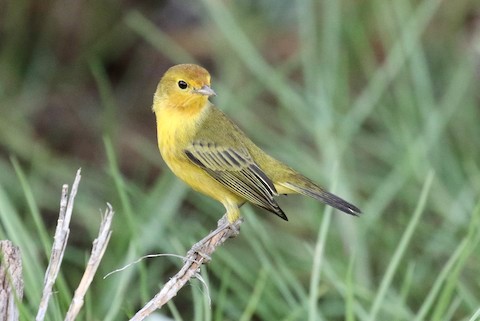
“Mangrove Warbler”, S. p. bryanti, female. (Ambergris Caye, Belize; November 14, 2019.) © John Bruin
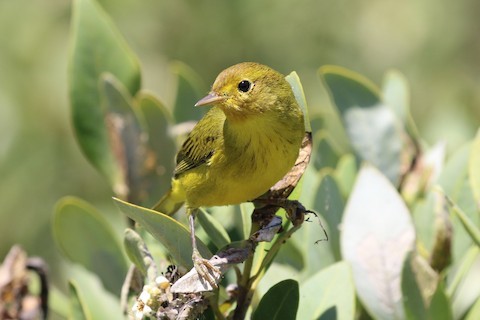
“Mangrove Warbler”, S. p. oraria, female. (Boca Chica Beach, Texas; July 13, 2018.) © Dan Jones
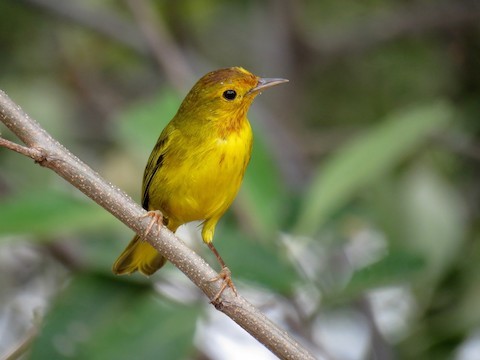
“Mangrove Warbler”, S. p. phillipsi, female or subadult male. (San Bernardo Wildlife Reserve, Choluteca, Honduras; February 4, 2017.) © John van Dort
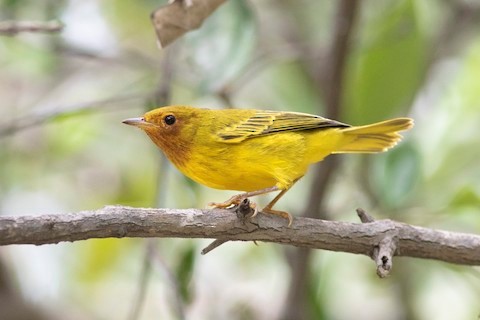
“Mangrove Warbler”, S. p. xanthotera, female or subadult male. (Chomes, Puntarenas, Costa Rica; September 9, 2018.) © Guillermo Saborío Vega

“Mangrove Warbler”, S. p. paraguanae, immature male. (Laguna Boca de Caño, Falcón, Venezuela; February 18, 2011.) © Lorenzo J. Calcaño
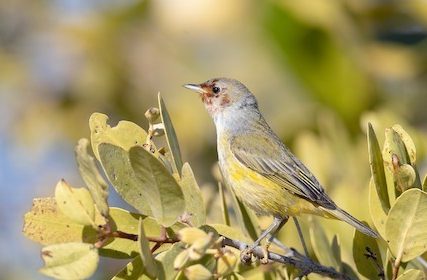
“Mangrove Warbler”, S. p. castaneiceps, immature male. (Mulegé, San Ignacio Lagoon, Baja California Sur, Mexico; December 25, 2020.) © Ian Davies
References
Alderfer, J., and J.L. Dunn. 2014. National Geographic Complete Birds of North America (Second Edition). National Geographic Society, Washington, D.C.
Ascanio, D., G.A. Rodriguez, and R. Restall. 2017. Birds of Venezuela. Christopher Helm, London.
BirdLife International. 2021. Setophaga petechia. The IUCN Red List of Threatened Species 2021: e.T22721657A137268484. https://dx.doi.org/10.2305/IUCN.UK.2021-3.RLTS.T22721657A137268484.en. (Accessed January 22, 2022.)
Browning, M.R. 1994. A Taxonomic Review of Dendroica petechia (Yellow Warbler) (Aves: Parulinae). Proceedings of the Biological Society of Washington 107:27-51.
Curson, J., D. Quinn, and D. Beadle. 1994. Warblers of the Americas: An Identification Guide. Houghton Mifflin, Boston.
eBird. 2022. eBird: An online database of bird distribution and abundance. Cornell Lab of Ornithology, Ithaca, N.Y. http://www.ebird.org. (Accessed January 22, 2022.)
Fagan, J., and O. Komar. 2016. Peterson Field Guide to the Birds of Northern Central America. Houghton Mifflin Harcourt, New York.
Howell, S.N.G., and S. Webb. 1995. A Guide to the Birds of Mexico and Northern Central America. Oxford University Press.
Johnson, O., and M.J. Billings. 2014. The Mangrove Yellow Warbler reaches California. Western Birds 45:160-162.
MacKinnon-Haskins, B., and A. Dzib-Chay. 2017. A New Population of Yellow Warbler (Setophaga petechia) on Cozumel Island with a Combination of Characteristics of Mangrove (S. p. bryanti) and Golden Warblers (S. p. rufivertex). Revista Mexicana de Ornitología 18:71-80.
McMullan, M., and T. Donegan. 2014, Field Guide to the Birds of Colombia (Second Edition). Fundación Proaves de Colombia, Bogotá.
Mennill, D.J. 2001. Song Characteristics and Singing Behavior of the Mangrove Warbler (Dendroica petechial bryanti). Journal of Field Ornithology 72:327-337.
Ridgely, R.S., and P.J. Greenfield. 2001. The Birds of Ecuador, Volume II: Field Guide. Cornell University Press.
Ridgely, R.S., and J.A. Gwynne. 1989. A Guide to the Birds of Panama (Second Edition). Princeton University Press.
Ridgely, R.S., and G. Tudor. 1989. The Birds of South America, Volume I: The Oscine Passerines. University of Texas Press.
Schulenberg, T.S., D.F. Stotz, D.F. Lane, J.P. O’Neill, and T.A. Parker. 2007. Birds of Peru. Princeton University Press.
Sibley, D.A. 2014. The Sibley Guide to Birds (Second Edition). Alfred A. Knopf. New York.
Stiles, F.G., A.F. Skutch, and D. Gardner. 1989. A Guide to the Birds of Costa Rica. Cornell University Press.
Xeno-Canto. 2022. Mangrove Warbler – Setophaga petechia. https://xeno-canto.org/species/Setophaga-petechia. (Accessed January 21, 2022.)
